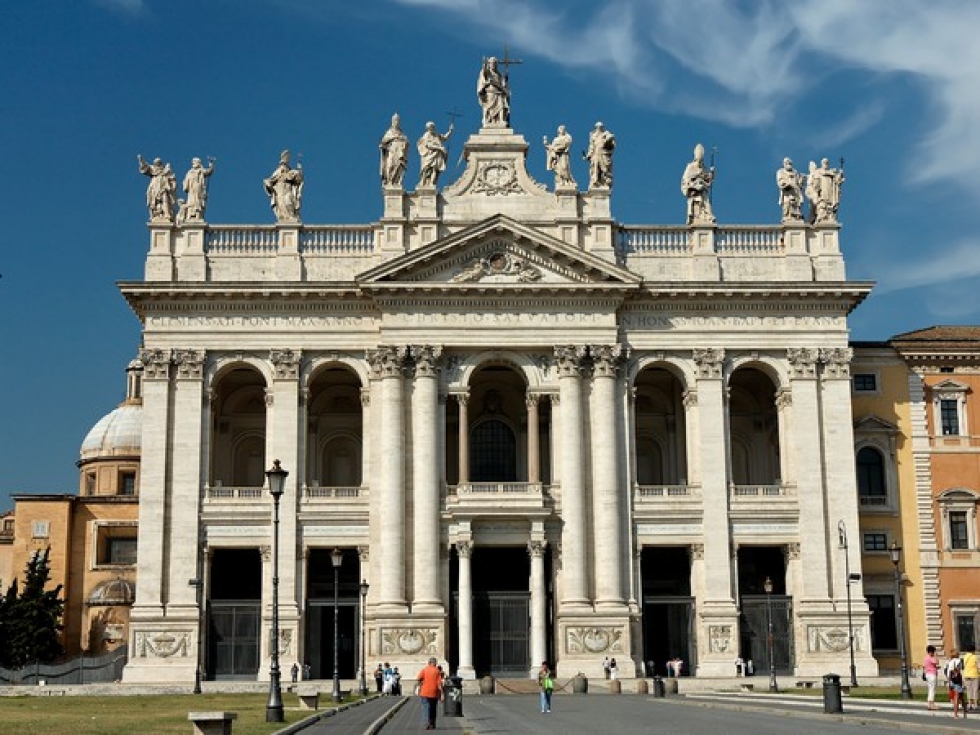Contrary to popular belief the ecclesiastical seat of the Pope is not St. Peter’s Basilica but the Archbasilica of St. John Lateran because the pontiff is also and especially Rome’s bishop. This basilica was built some years before the one of St. Peter and so it’s the oldest in the world. The church was inaugurated by Pope Sylvester I in 324 A.D. and was initially dedicated to the Savior but through the centuries was also dedicated to St. John the Baptist and then St. John the Evangelist.
It is called “Lateran” because it was built on the lands once owned by the Lateran family who gave them to the Church perhaps at the end of the III century.
Throughout the centuries the basilica was subjected to radical modifications which made it appear very different from its original look but it has kept its 5 naves system and some very important works of previous ages. The interior as we see it today is the result of the two interventions by the Baroque genius of Francesco Borromini during the XVII century (precisely in 1646-50 and in 1656-57). The marvelous façade instead, is of the first half of the XVIII century. It is almost impossible to enumerate all the incredible artistic works that are located in the basilica, but we will try to recall just a few for our readers.
Among these works we have to remember the amazing central gate of the basilica with its bronze shutters original of the Roman Curia (the famous seat of the Roman Senate) that were moved here in 1660. You can’t enter St. John Lateran without being amazed by the 12 giant niches – made by Borromini – which contain the majestic Apostles’ statues. Equally beautiful is the Medieval Cosmatesque floor and the coffered ceiling of the Renaissance.
In the right nave we can admire a Giotto’s fresco which depicts Pope Boniface VIII proclaiming the first Jubilee – the one of 1300 -. It’s one of the few works by Giotto in Rome.
We can’t also forget the mosaic in the vault of the apse – a III century work by Jacopo Torriti restored during the XIX century – which depicts Christ surrounded by angels and standing on a hill (Jerusalem) from which 4 rivers (the 4 Gospels) that quench the flock’s thirst (the devotees) descend. In front of it stands the papal altar from which only the Pope can officiate. It’s a masterpiece from 1367 and on its superior side it still has the wood altar which is believed to have been used by the very first Popes.
This basilica is also linked to various fun facts that make it unique. For example, in 896 Pope Formosus was taken to trial in this church because he was accused of becoming pontiff in a deceitful way. Nothing strange except for the fact that Formosus was already dead when he was judged! His corpse was exhumed, dressed with the sacred vestments, put on the throne and judged by the prelates reunited in synod. He was found guilty and Pope Stephen VII decided to drag the dead body through the streets of Rome and then throw it in the Tiber.
But that’s not the only interesting event linked to the Roman Basilica. A magic tomb lies inside it! It’s the sepulchre of Pope Sylvester II – Pope from 999 to 1003 – who was a great researcher and cultured person and was considered a powerful wizard by someone. According to a peculiar legend his original tomb – the current one was rebuilt in 1648 – became wet when a Pope was about to die and sometimes it also emitted strange sounds caused by the vibration of Sylvester’s bones. As if the remains of the pontiff skeleton was starting to tremble!
Giuseppe Rosselli




